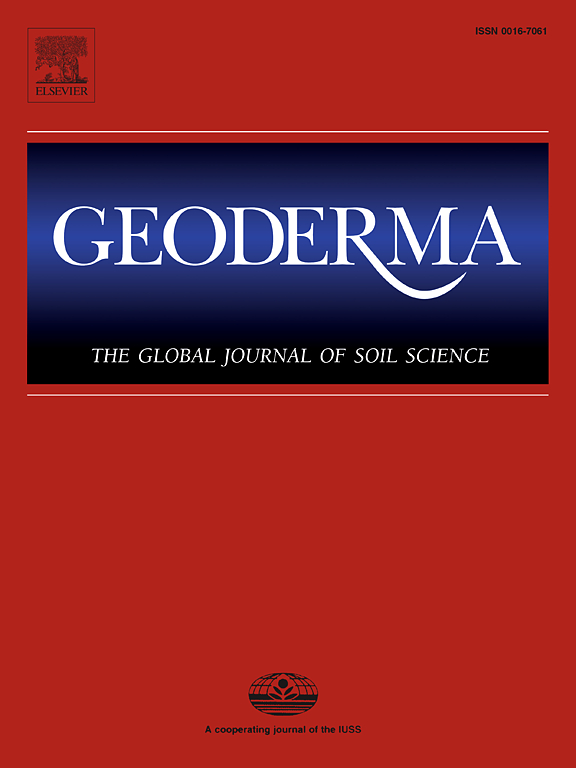土壤气体和溶质扩散率作为春季施肥后N2O排放的预测因子:一个完整土壤的孵化研究
IF 5.6
1区 农林科学
Q1 SOIL SCIENCE
引用次数: 0
摘要
农业土壤是人为向大气排放N2O的主要来源。为了有效地减少这些排放,需要了解现场条件下潜在驱动因素之间的相互作用。我们进行了一个培养实验,将完整的土芯调整为四种基质电位(- 15、- 30、- 50或- 100 hPa)之一。在孵育前,我们测量了四种表面施肥处理的相对气体扩散率(Dp/Do)和有效充气孔隙率(εeff): NS26-13 (NS), 50 kg N ha−1 (NS50;起动器);50 + 100 kg N ha−1 (NS150);在50 + 100 kg N ha−1时,主剂量为100 kg N ha−1,含硝化抑制剂3,4-二甲基吡唑磷酸(NS150 + DMPP);和未受精的对照组。我们对N2O通量进行了35天的监测,发现N2O通量与基质电位呈正相关,与Dp/Do和εeff呈弱负相关。35 d后,对岩心进行切片,测定矿物氮库和潜在氨氧化(PAO)。NH4+呈较强的梯度,随深度下降,表明硝化作用发生在离施用肥料一定距离的地方,这与PAO和pH分布一致。35 d后0-2 ~ 2-4 cm深度土壤溶液中NH4+通量与−30 ~−100 hPa N2O排放呈一致关系,表明硝化作用是该范围内N2O的主要来源。这项研究的结果表明,气体和溶质扩散率都必须考虑到预测N2O排放的表面施用肥料。本文章由计算机程序翻译,如有差异,请以英文原文为准。
Soil gas and solute diffusivity as predictors of N2O emissions after spring fertilization: An incubation study with intact soil
Agricultural soils are the main source of anthropogenic N2O emissions to the atmosphere. To effectively mitigate these emissions there is a need to understand the interactions between potential drivers under field conditions. We conducted an incubation experiment with intact soil cores adjusted to one of four matric potentials (−15, −30, −50 or −100 hPa). We measured the relative gas diffusivity (Dp/Do) and effective air-filled porosity (εeff) before incubation with four surface-applied fertiliser treatments: NS26-13 (NS) at 50 kg N ha−1 (NS50; starter); NS at 50 + 100 kg N ha−1 (NS150); NS at 50 + 100 kg N ha−1, the main dose of 100 kg N ha−1 containing the nitrification inhibitor 3,4-dimethylpyrazol phosphate (NS150 + DMPP); and an unfertilized Control. We monitored N2O fluxes for 35 days and found a positive relationship with matric potential and a weak inverse relationship with Dp/Do and εeff.. After 35 days, the cores were sectioned for determination of mineral N pools and potential ammonia oxidation (PAO). A strong NH4+ gradient, declining with depth, was observed which indicated that nitrification took place at some distance from the surface-applied fertiliser, and this was consistent with PAO and pH distributions. The flux of NH4+ in the soil solution between 0–2 and 2–4 cm depth after 35 days showed a consistent relationship with N2O emissions at −30 to −100 hPa indicating nitrification was the main source of N2O in this range. The results of this study suggest that both gas and solute diffusivity have to be considered for predicting N2O emissions from surface-applied fertilisers.
求助全文
通过发布文献求助,成功后即可免费获取论文全文。
去求助
来源期刊

Geoderma
农林科学-土壤科学
CiteScore
11.80
自引率
6.60%
发文量
597
审稿时长
58 days
期刊介绍:
Geoderma - the global journal of soil science - welcomes authors, readers and soil research from all parts of the world, encourages worldwide soil studies, and embraces all aspects of soil science and its associated pedagogy. The journal particularly welcomes interdisciplinary work focusing on dynamic soil processes and functions across space and time.
 求助内容:
求助内容: 应助结果提醒方式:
应助结果提醒方式:


